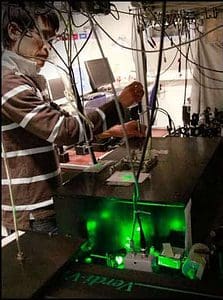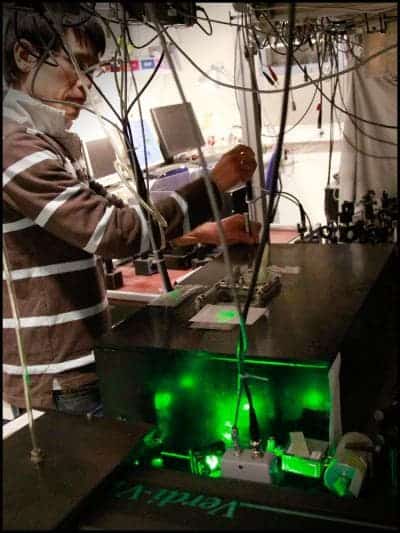
By harnessing the science of both quantum and nano physics, scientists at the Niels Bohr Institute have come up with an innovative new way of cooling semiconductor membranes by using laser light. Through this new technique, the researchers were able to cool the tiny, thin membrane from room temperature to -269 degrees Celsius. Paradoxically, the laser warms the bulk semiconductor material as a whole, so one could claim that they achieved cooling by heating.
Semiconductor chips, for instance, are vital in today’s information age, and while technology tends to become ever miniaturized, the need for a more efficient energy consumption and cooling is required if tomorrow’s smartphones and tablets are to become smarter, more efficient or cheaper.
For many years now, scientists at the Niels Bohr Institute have successfully managed to cool gas atoms using laser, actually very close to absolute zero (-273 degrees Celsius), by creating entanglement between two atomic systems.
For some time we have wanted to examine how far you can extend the limits of quantum mechanics – does it also apply to macroscopic materials? It would mean entirely new possibilities for what is called optomechanics, which is the interaction between optical radiation, i.e. light, and a mechanical motion,” explains Professor Eugene Polzik, head of the Center of Excellence Quantop at the Niels Bohr Institute at the University of Copenhagen.
The researchers created semiconductor “membranes” with a thickness of 160 nanometers and a surface area of 1 millimeter by 1 millimeter. In their experiments, the scientists fired the laser in such a way that it influenced the mechanical movements of the membrane, until they reached a certain oscillation mode of the membrane, which allowed it to be cooled from room temperature down to minus 269 degrees C.
“The paradox,” explains Koji Usami, associate professor at Quantop at the Niels Bohr Institute., “is that even though the membrane as a whole is getting a little bit warmer, the membrane is cooled at a certain oscillation and the cooling can be controlled with laser light. So it is cooling by warming! We managed to cool the membrane fluctuations to minus 269 degrees C.”
“It would mean entirely new possibilities for what is called optomechanics, which is the interaction between optical radiation, i.e. light, and a mechanical motion.”
The research, published in a recent edition of the journal Nature Physics, paves the way for a range of new opportunities in the field called optomechanics, which studies the interaction between optical radiation (light) and mechanical motion. Most definitely, quantum computing will profit from this cool research. My puns can be terrible, granted.
“Efficient cooling of mechanical fluctuations of semiconducting nanomembranes by means of light could also lead to the development of new sensors for electric current and mechanical forces… Such cooling in some cases could replace expensive cryogenic cooling, which is used today and could result in extremely sensitive sensors that are only limited by quantum fluctuations,” added Polzik.









